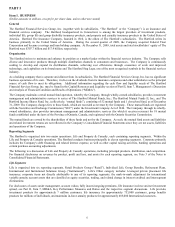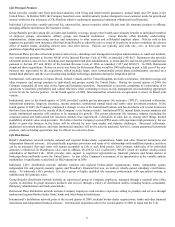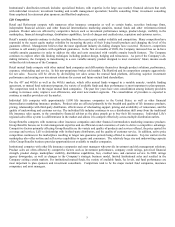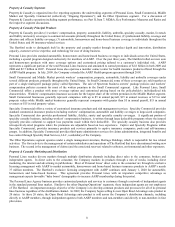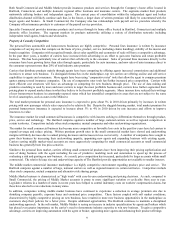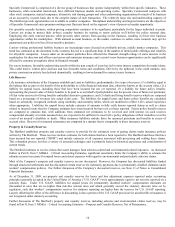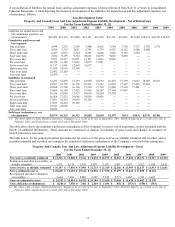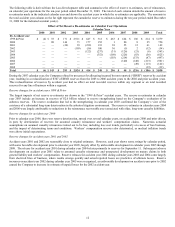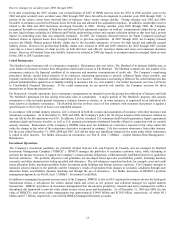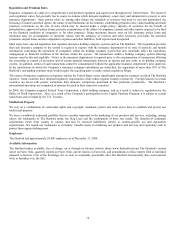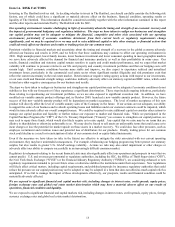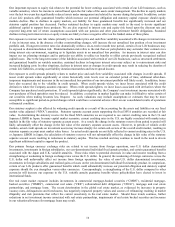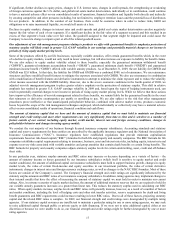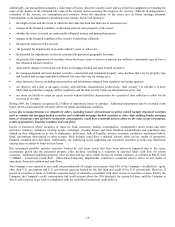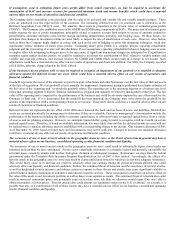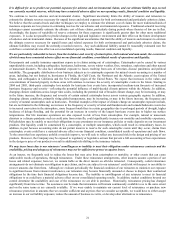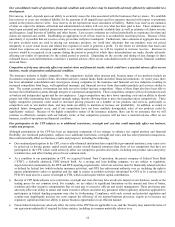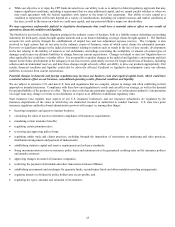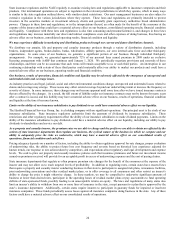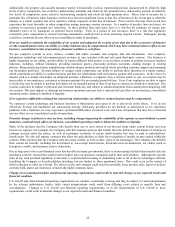The Hartford 2009 Annual Report Download - page 15
Download and view the complete annual report
Please find page 15 of the 2009 The Hartford annual report below. You can navigate through the pages in the report by either clicking on the pages listed below, or by using the keyword search tool below to find specific information within the annual report. 15
Item 1A. RISK FACTORS
Investing in The Hartford involves risk. In deciding whether to invest in The Hartford, you should carefully consider the following risk
factors, any of which could have a significant or material adverse effect on the business, financial condition, operating results or
liquidity of The Hartford. This information should be considered carefully together with the other information contained in this report
and the other reports and materials filed by The Hartford with the SEC.
Our operating environment remains challenging in light of uncertainty about the timing and strength of an economic recovery and
the impact of governmental budgetary and regulatory initiatives. The steps we have taken to realign our businesses and strengthen
our capital position may not be adequate to mitigate the financial, competitive and other risks associated with our operating
environment, particularly if economic conditions deteriorate from their current levels or regulatory requirements change
significantly, and we may be required to or we may seek to raise additional capital or take other strategic or financial actions that
could adversely affect our business and results or trading prices for our common stock.
Persistent volatility in financial markets and uncertainty about the timing and strength of a recovery in the global economy adversely
affected our business and results in 2009, and we believe that these conditions may continue to affect our operating environment in
2010. High unemployment, lower family income, lower business investment and lower consumer spending in most geographic markets
we serve have adversely affected the demand for financial and insurance products, as well as their profitability in some cases. Our
results, financial condition and statutory capital remain sensitive to equity and credit market performance, and we expect that market
volatility will continue to pressure returns in our life and property and casualty investment portfolios and that our hedging costs will
remain high. Until economic conditions become more stable and improve, we also expect to experience realized and unrealized
investment losses, particularly in the commercial real estate sector where significant market illiquidity and risk premiums exist that
reflect the current uncertainty in the real estate market. Deterioration or negative rating agency actions with respect to our investments,
or our own credit and financial strength ratings, could also indirectly adversely affect our statutory capital and RBC ratios, which could
in turn have other negative consequences for our business and results.
The steps we have taken to realign our businesses and strengthen our capital position may not be adequate if economic conditions do not
stabilize in line with our forecasts or if they experience a significant deterioration. These steps include ongoing initiatives, particularly
those relating to repositioning our investment portfolios, so we are also exposed to significant execution risk. In addition, we have
modified our variable annuity product offerings and, in October 2009, launched a new variable annuity product. However, the future
success of this new variable annuity product will be dependent on market acceptance. The level of market acceptance of this new
product will directly affect the level of variable annuity sales of the Company in the future. If our actions are not adequate, our ability
to support the scale of our business and to absorb operating losses and liabilities under our customer contracts could be impaired, which
would in turn adversely affect our overall competitiveness. We could be required to raise additional capital or consider other actions to
manage our capital position and liquidity or further reduce our exposure to market and financial risks. While we participated in the
Capital Purchase Program (the “CPP”) of the U.S. Treasury Department (“Treasury”) as a means to strengthen our capital position, we
may seek to repay those funds, which would also likely require us to raise capital. Any capital that we raise may be on terms that are
dilutive to shareholders or otherwise unfavorable to us. We may also be forced to sell assets on unfavorable terms that could cause us to
incur charges or lose the potential for market upside on those assets in a market recovery. We could also face other pressures, such as
employee recruitment and retention issues and potential loss of distributors for our products. Finally, trading prices for our common
stock could decline as a result or in anticipation of sales of our common stock or equity-linked instruments.
Even if the measures we have taken (or take in the future) are effective to mitigate the risks associated with our current operating
environment, they may have unintended consequences. For example, rebalancing our hedging program may better protect our statutory
surplus, but also results in greater U.S. GAAP earnings volatility. Actions we take may also entail impairment or other charges or
adversely affect our ability to compete successfully in an increasingly difficult consumer market.
Regulatory developments relating to the recent financial crisis may also significantly affect our operations and prospects in ways that we
cannot predict. U.S. and overseas governmental or regulatory authorities, including the SEC, the Office of Thrift Supervision (“OTS”),
the New York Stock Exchange (“NYSE”) or the Financial Industry Regulatory Authority (“FINRA”), are considering enhanced or new
regulatory requirements intended to prevent future crises or otherwise stabilize the institutions under their supervision. New regulations
will likely affect critical matters, including capital requirements, and published proposals by insurance regulatory authorities that could
reduce the pressure on our capital position may not be adopted or may be adopted in a form that does not afford as much capital relief as
anticipated. If we fail to manage the impact of these developments effectively, our prospects, results and financial condition could be
materially adversely affected.
We are exposed to significant financial and capital markets risk, including changes in interest rates, credit spreads, equity prices,
foreign exchange rates and global real estate market deterioration which may have a material adverse effect on our results of
operations, financial condition and liquidity.
We are exposed to significant financial and capital markets risk, including changes in interest rates, credit spreads, equity prices, foreign
currency exchange rates and global real estate market deterioration.


